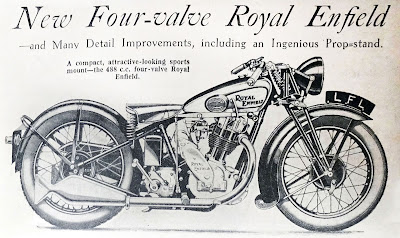 |
| An "ingenious prop stand" was headline news for Royal Enfield. (From The Motor Cycle) |
Was this the worst idea Royal Enfield ever had? See what you think.
For the 1932 model year, Royal Enfield introduced on a few top-line models a folding center stand that doubled as a kickstand.
My guess is that this was a little bit too clever.
It was an appealing idea, though. To park, the rider, still mounted, could use his foot to press the center stand down so that it touched the ground. A pawl on the rear brake arm would catch the stand in this position.
The rider could then dismount, with the partly extended center stand keeping the motorcycle stable enough to stand by itself. The rider wouldn't have to huff the motorcycle fully up onto the its center stand, or even stretch out a leg to use a conventional kickstand.
To depart, the rider could simply mount, touch the brake pedal with his foot, thus disengaging the pawl, and the center stand would spring up.
The motoring press was impressed. Motor Cycling Magazine reported that "The Enfield Company seems to have evolved something both new and efficient."
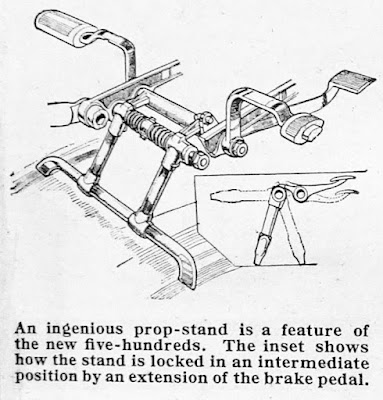 |
| Keep in mind that the brake pedal is on the right-hand side of the motorcycle in this era. (From The Motor Cycle) |
The Motor Cycle for Sept. 17, 1931 described it this way:
"A point which will appeal to all practical motorcyclists is the inclusion of a double prop-stand with unusually wide base legs. There are three positions for this stand: (1) raised, (2) in normal use as a central stand, and (3) an intermediate position in which the stand is lowered sufficiently to prop up the machine on either side. In this position it is locked by a rearward extension of the brake pedal.
"There is no need to touch the stand by hand, for pressure of the toe while the rider straddles the machine will bring the prop-stand into action and, to release it, it is only necessary to touch the brake pedal."
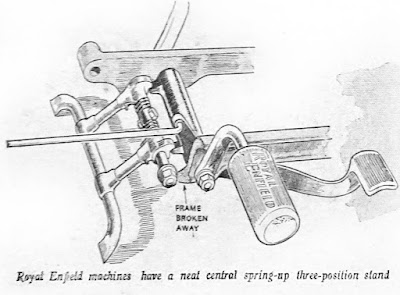 |
| Another view of the new stand in "propping" position. (From Exporter Trader) |
You see the problem, of course.
That partially extended center stand seems just a-slip-of-the-brake-pedal away from springing up and leaving the motorcycle to fall on its side.
This appears to be the sort of happy new feature that "demos" well in the showroom, but no one would ever deliberately trust in the field.
In use, the partly extended stand gives the motorcycle the look of a wounded goose, or an airplane with its landing gear jammed.
My guess is that users soon tired of passersby warning that, "hey, your stand isn't all the way down!"
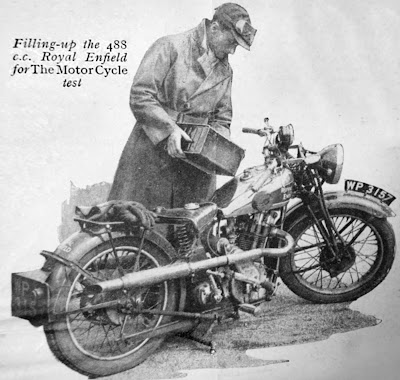 |
| In use the prop stand looks insecure, even though it is extra wide. (From The Motor Cycle) |
Instead of a light touch, it might have taken a firm push on the pedal to free the stand.
In fact, to me, this suggests that, on the wrong piece of ground, the motorcycle could get caught with the stand stuck in propping position. One imagines the rider appealing to buddies to help lift the motorcycle enough to allow the center stand to escape the pawl.
Introduced for 1932 on the Model L and the sporting Model LF four-valve, the perhaps all-too-clever prop stand was released by a touch on the foot brake pedal, which was on the right side of the motorcycle (facing forward) in this era.
But foot gear shifting was introduced for these models in 1933; so the brake pedal had to move to the left side of the machine to make room for the gearshift lever.
Since the drum brake itself remained on the right side of the rear wheel, the foot brake worked via a cable that crossed over to the other side.
Did this force a redesign of the "ingenious" prop stand? By 1934 The Motor Cycle was referring to the mechanism as being activated by a "trigger on the brake pedal."
Had the pawl been replaced by some more secure catch on the brake pedal itself? At least the "trigger" sounds more likely to disengage when wanted than the pawl, no matter what ground the machine is on.
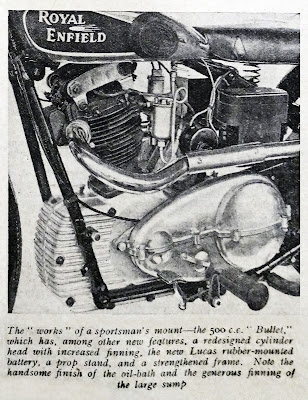 |
| Brake pedal moved to left of the motorcycle. It looked like this for 1934. (From The Motorcycle) |
Whatever its form, the "very practical Royal Enfield prop stand" would continue for 1935 on the top sporting machine, now with a three-valve motor and called the Model LO. That model quickly became the slightly detuned Model LO2, with a cut in price, but the "very good" prop stand was retained.
It remained again in 1936 when the LO2 was replaced by the four-valve JF.
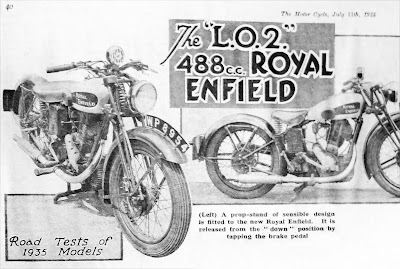 |
| Prop stand shown fully down, left, and as "propped," above. |
Motor Cycling magazine tested the two-valve 500cc Royal Enfield J2 in March, 1937, and lavished praise on its prop stand:
"Equipped not only with a particularly sensible sort of spring-up rear stand, the Royal Enfield also has a prop stand, which can be dropped or lifted by the touch of a toe. The usefulness of a stout prop stand, as apart from a central stand, has to be tried to be appreciated and few riders, once having had such a fitting, would willingly relinquish it."
But relinquish it, they would. The press, ever eager to mention a new feature, doesn't seem to report the discontinuation of the prop stand. Press clippings in the archives of the Royal Enfield Owners Club UK don't seem to include a mention of it being dropped, as far as I could find.
And so disappeared a clever convenience, of doubtful use but still much-praised by the always enthusiastic motoring press. Royal Enfield riders would go back to huffing their machines up onto the fully extended center stand.
Cable operation of the rear brake would go away, too, and a solid brake rod would soon return on Royal Enfields. But the three-position prop stand hasn't come back, to my knowledge.
Anyway, I suspect such a device probably could only have worked on the hard-tail motorcycles of its day. With a modern sprung rear suspension the partly extended stand would have come clear of the ground the moment the rider stepped off his mount, leaving the motorcycle to topple.
Anyone familiar with the old prop stand willing to spring to its defense? Please leave a comment.
No comments:
Post a Comment